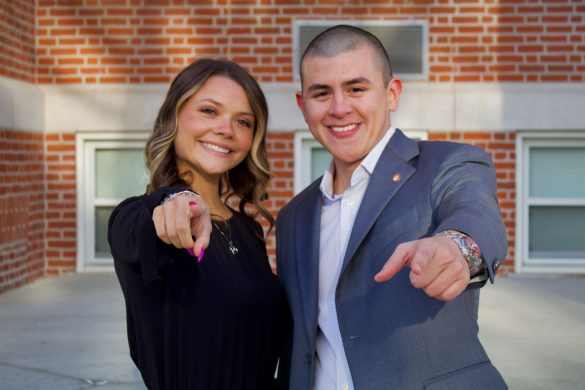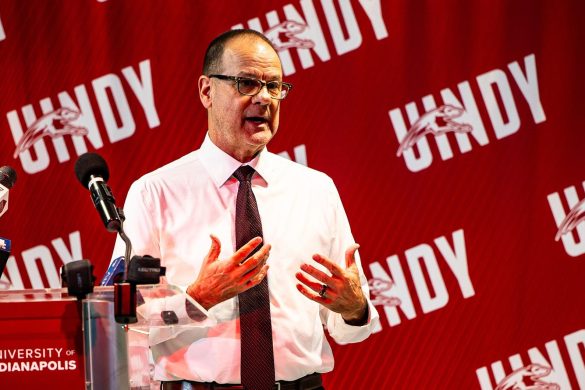New safety measures have been implemented on the University of Indianapolis campus to address a lack of cellular reception in certain parts of campus. The Alertus Beacon System will send out alerts to warn students, faculty and staff in case of severe weather, crime and any other threats on or near campus, according to the Alertus website.
The alert beacons are small, compact audible-visual alerting devices that can deliver critical emergency messages to everyone in the vicinity, according to the Alertus website.
Campus Police Chief David Selby said that implementing the new alert system is a result of the 2016 bomb threat at UIndy. He explained that in similar situations, informing students quickly and efficiently is essential. Selby also said that because of the lack of cellular reception in certain areas on campus and the possibility of students or visitors without access to cell phones, sending Watchdog alerts was not enough.
“The beacons work off our infrastructure. It is hooked up with our Watchdog system. So when we issue out a Watchdog, it is automatically sent to Alertus, which then sends it to the beacons,” Selby said. “It is tough getting messages down at the Health Pavilion, so this [beacon system] is going to resolve the issue.”
According to the Alertus website, the alert beacons are designed for large facilities, such as college campuses and military bases, that lack in-building emergency notification systems. The beacons are not dependent on cell phone towers or the Internet, but can be connected via Ethernet or Wi-Fi.
There are 16 alert beacons mounted to the walls in nine buildings around campus, including Lilly Science Hall, the Athletic Recreation Center, Schwitzer Student Center, Warren Hall, the Health Pavilion, Krannert Memorial Library, Cravens Hall, Ruth Lilly Fitness Center and Esch Hall.
In the event of an emergency, the beacon will flash and sound to capture the attention of building occupants while displaying a custom message regarding the emergency and how students, faculty and staff should respond. Emergency notifications also can be sent to every installed beacon or only to select ones, depending on the extent of the emergency, according to the Alertus website.
According to Selby, Indianapolis Student Government and the Resident Hall Association were crucial to the process of installing the Alertus Beacon System on campus by getting funding through a grant. Selby said that student support helped expedite the process of getting the system.
“Without the students [in ISG and RHA], we wouldn’t have this system,” Selby said. “Without the students, I never would have gotten the equipment as quickly as I did.”
Selby said the campus now has desktop solutions to enhance campus security. He said that campus police also partnered with Information Technology and the marketing department to update emergency procedures documents and provide all faculty and staff with emergency desktop guides that can be found on the MyUIndy website.
President of ISG and junior international relations and political science major Taylor Carpenter said that implementing the beacon system, especially in places with poor cellular service, was important because of the number of community events hosted on campus.
“ISG has always been looking to improve security on campus and with the bomb threat [in the fall 2016]… a lot of students started thinking, ‘What can we do?’ and ‘How can we better improve?’” Carpenter said. “We have been looking at different ways, especially with the Health Pavilion because you don’t get good cell service in there. Not many students got the Watchdog [regarding the bomb threat], and that was obviously an issue.”
Co-President of the Residence Hall Association senior biology and Spanish major Kennedy Nies explained that implementing the beacon system on campus was essential for maintaining students’ safety.
“After the [bomb] threat on campus last year, there are a lot of issues with the Health Pavilion not being able to get reception, [and the] basements of Warren and Cravens,” Nies said. “So it is important to think about how we can prevent them [students] from not getting the information. Say if someone was isolated in the basement studying or isolated somewhere [on campus, by implementing the system], they will still be able to get the information to stay safe.”
Both Carpenter and Nies said that implementing the beacon system was an opportunity to maintain the missions of ISG and RHA and keep campus safe.
“Our mission through the RHA is to listen to what the students want and what they want to see implemented and how it can better their experience on campus,” Nies said. “When situations like the bomb threat occur, we [RHA] can be more prepared [with the beacon system], and the students are able to know that they are going to get information they need.”









